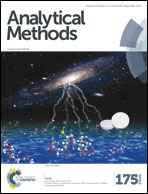Comparison of the roots of Salvia miltiorrhiza Bunge (Danshen) and its variety S. miltiorrhiza Bge f. Alba (Baihua Danshen) based on multi-wavelength HPLC-fingerprinting and contents of nine active components†
Abstract
The dried root of Salvia miltiorrhiza Bunge (Danshen in Chinese, ZHDS) is a very commonly used herbal medicine with purple flowers, and the dried root of S. miltiorrhiza Bge f. Alba (Baihua Danshen in Chinese, BHDS) with white flowers is a variety of ZHDS that is also used in clinics in some areas of China. Their authentication has always been a challenging task due to their similar morphological characteristics and ingredients. In the present study, an effective method for identifying BHDS and ZHDS based on multi-wavelength HPLC-fingerprinting chromatographic analysis and chemometric methodology was established. Peak-rich wavelengths (203, 270 and 281 nm) were combined to build a multi-wavelength fingerprint for each sample. Simultaneously, single-wavelength fingerprinting at 281 nm and content determination of nine active compounds were carried out. The results showed that a classification model between ZHDS and BHDS based on multi-wavelength fingerprint profiling was better than that on single-wavelength, and their discrimination became more feasible. The difference in components was not directly revealed, but latent information was revealed by PCA and PLS-DA. There were no significant differences in the contents of the nine main components (danshensu, caffeic acid, rosmarinic acid, lithospermic acid, salvianolic acid B, dihydrotanshinone I, cryptotanshinone, tanshinone I and tanshinone IIA). The results suggest that BHDS and ZHDS are chemically distinct and need to be evaluated for clinical applications.


 Please wait while we load your content...
Please wait while we load your content...